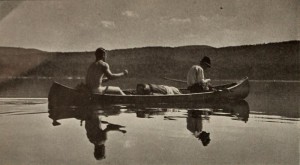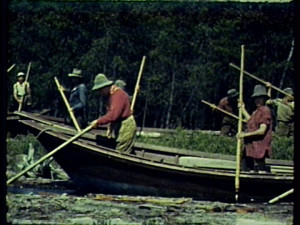"Local newsreel events include carnival scenes at Winsford, Cheshire. Dancing troupes, decorated floats and various fancy dress characters march along the country lanes. Also features the Southport Flower Show held on August 24th,1934. Includes indoor exhibits, rock gardens and an outdoor swimming pool. Concludes with the crowning ceremony of Morecambe carnival queen. Crowds of people, sitting in rows of deckchairs, watch the event taking place." (NWFA Online Archive)
"Local newsreel - includes items on the 'New World Wonder Tunnel' in Merseyside, March 31st 1934; Manchester City football team is welcomed home after winning the FA cup at Wembley - includes scenes at North Edgeley Station and Piccadilly Square - A royal visit to Manchester and Liverpool, July 17th / 18th, 1934. King George V is greeted by large crowds as he opens the new Central Reference Library in Manchester and the new East Lancashire Road in Liverpool. The newsreel concludes with shots of Stockport’s floral tributes." (NWFA Online Archive)
"Popular North West events from 1934 feature here. Stockport Ladies' baths reopens, with young swimmers keen to display their skills. Local people turn out for the Alderley Edge carnival parade, and huge crowds flock to see Sir Alan Cobham's Air Pageant at Woodford Aerodrome. Finally, we leave Cheshire for a trip to New Brighton, where again the crowds turn out, for fun in the new pool." (BFI Player)
"A Glimpse of Paris shows us the usual sights of the French capital as well as some of the less common places. Tight editing keeps the film moving yet the feel of jumping rapidly from one spot to another, so often prevalent in travel films, is not present in this one" PSA Journal, Sept. 1964, 50.

"The refreshing story of a voyage by river into the Canadian wilds, presented by F. R. Crawley in Glimpses of a Canoe Trip, is really deserving of a less modest introduction than that implied by the word, "glimpses." Here, within one reel, is as comprehensive a movie tale of a trip by canoe as one could desire. The entertaining continuity, based on the natural sequence of events, is not loaded with unimportant detail; instead, footage is conserved for the more interesting episodes involved in paddling and portages. These are given a well rounded treatment that has genuine entertainment value coupled with a freshness of approach born of the enthusiasm of the maker. This sort of thing communicates itself to the audience, especially when photography, editing and titling are as well handled as they are here." Movie Makers, Dec. 1937, 629.
"Item is a film taken by Dr. Willinsky of a trip to Rome, Italy. In the form of a travelogue, footage of landmarks, ruins and the local population are interspersed with captions that were added in by Dr. Willinsky to provide information about the country's history and culture. Included are shots of the Pantheon, the Colosseum, a Roman market, the Appian Way and dinner at a Roman restaurant. Dr. Willinsky's wife, Sadie, is occassionally spotted in the footage with travel companions who are probably relatives or family friends." Ontario Jewish Archives.
"Glimpses of Rural Hungary was the first film ever made by Elizabeth Rearick but its excellence must be credited to more than beginner's luck. It represents a willingness to follow instructions carefully and an ability to compose scenes as they are selected. The picture contains a charming record of the people and customs of Hungary, but capturing this was secondary, for Miss Rearick planned the film to be principally a record of folk dances. Most unusually accurate exposure and focusing make the film outstanding in its technical aspects. Clear, crisp, steady pictures inevitably do a great deal to present a subject in a delightful way. One of the remarkable features of the film was the rock steadiness of the camera, although Miss Rearick did not use a tripod at any time. The sequencing is worked out well and, although the film is intended for use in physical education work, it has a tremendous general interest value. The entire finished product is one of which an experienced filmer might well be proud." Movie Makers, Dec. 1933, 500.
"Record of a Woodley family trip to the Gaspé." Library and Archives Canada.

"A background film, to be used to 'point up' a lecture (or sermon) on the benefits Nature disposes upon us" American Cinematographer, May, 1938, 204.
"The Abbé Tessier, who is a lecturer at Laval University, Quebec, made this film for use in connection with his own educational work. The film should be viewed with this in mind" American Cinematographer, April, 1938, 170.
Total Pages: 299